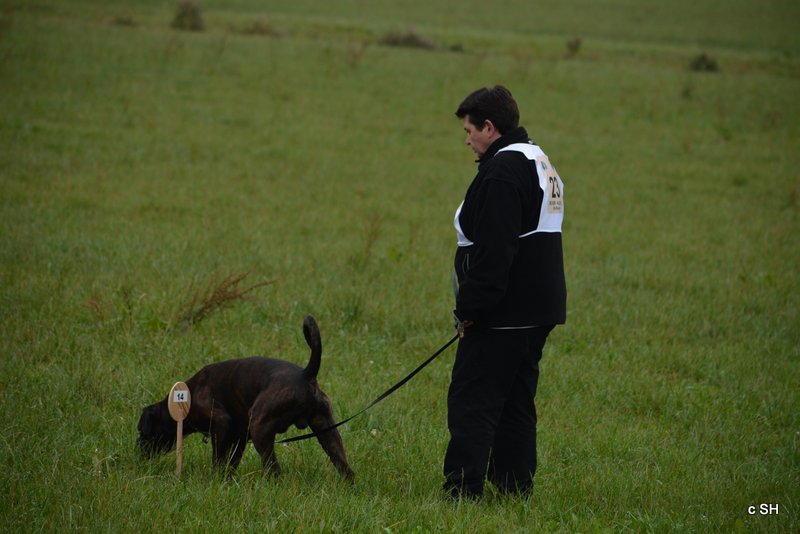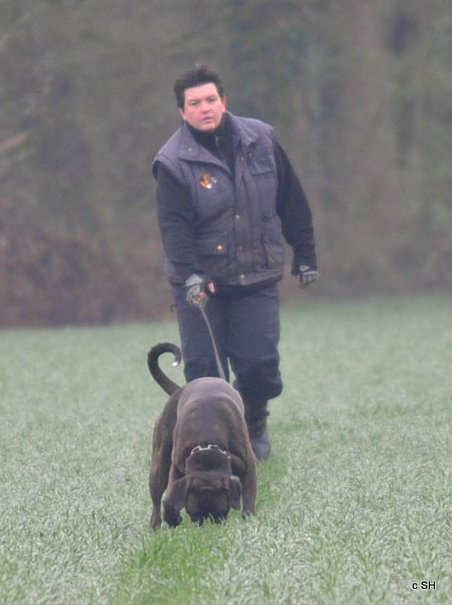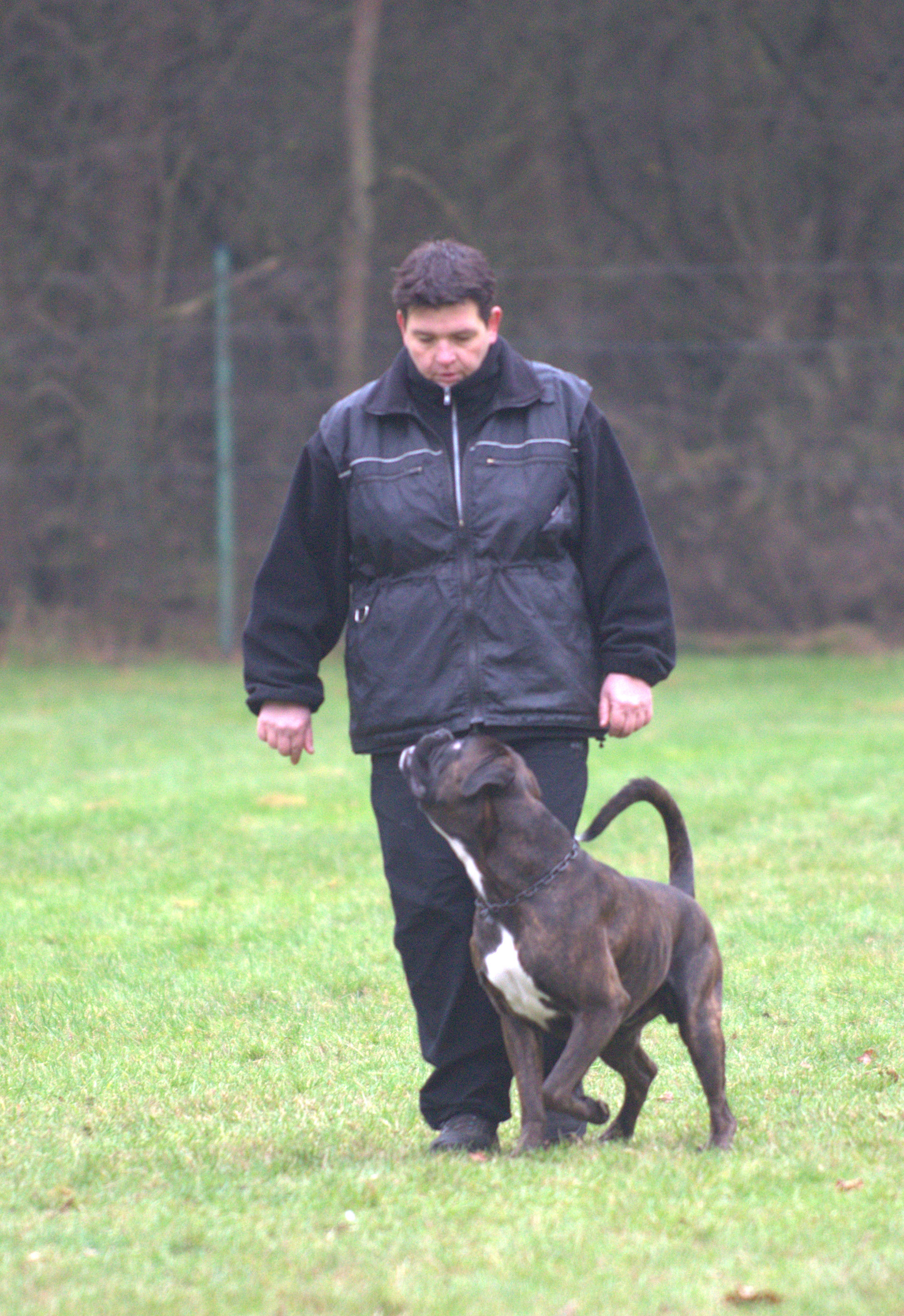Dog sport
In 1977 Willi Jurasik took me to the dog training area and I learned my first steps in working dog sport with Amor and Boris v. Wörsbachtal. In the context of the youth cup of the regional group Westphalia I made then with 10 years with Amor my first examination in May 1978 in Rheine. We won the cup and for me it was clear - this is my sport!
From then on I trained diligently with Amor and partly also with Boris every Saturday, did tracks and later even tried a a helper. Willi took me to every test and I owe him an incredible amount!
In 1980 I got my first own boxer, Don v. Heitmannshof. He was followed in 1991 by Bajou v. Eickeberg, in 2001 by Festus v. Frankenland, in 2011 by Cejay v. Eventus and in 2018 by Cejay's son Garvin v. Alt-Bayern. They all were and are led in working dog sport and I could celebrate some successes with them, but most of all I found a lot of like-minded people and some good friends in the world! In the meantime I am a performance judge for working dog sport myself since 2017 :)
- What is dog sport?
- Prerequisite for all: companion dog test
- IGP
- Tracking
- Obedience
- Protection service
What is dog-sport
Dog sport in itself is sport that is performed with the dog and thus a more than meaningful occupation for dog and handler 😊.
One promotes thereby not only the fitness of dog and dog handler, but you will see that the dogs are exhausted by the necessary "thinking" and concentration quite differently. In addition, training together and engaging with the dog and asking "How is my dog learning this?" leads to a better relationship with your dog. You´ll get a much more intense bond with your dog!
But what is dog sport? Under the term dog sports are numerous occupations with the dog such as: Agility, companion dog sport, tournament dog sport, Obidience, cross-country running or Canicross, Flyball, Dogdancing, Mantrailing and many more. On the pages of the VdH and the FCI you will find the nationally and internationally recognized sports.
The oldest dog sport at all is the working dog sport, or also Utility dog sport, which was called in former times also protection dog sport.
The sport originates from the police dog training and the Boxer was already recognized as a service dog breed in 1924! The dog and the handler have to fulfill different tasks in the three departments tracking, obedience and protection, depending on the test level.
Prerequisite for all: Companion dog test with behaviour test (BH-VT)
In order to do any further sports with a dog and participate in tests, tournaments or competitions, a passed companion dog test with behavior test (BH-VT) is a prerequisite - all official sports have this in common.
Thus, the BH-VT is the entry-level test for all, which can be taken at 15 months of age. It consists of a subordination with the exercises:
- Heeling on leash
- free heeling
- sit out of motion
- down with recall
- down under distraction
Furthermore, in the so-called traffic part, the behavior of the dog towards its environment (people, cyclists, cars, encounters with other dogs, etc.) is tested. Here the dog's character should be tested and it must not show any aggressiion.
One sport - umpteen names: Schutzhund (SchH), Gebrauchshund, Vielseitigkeitssport (VPG), IPO (which was actually just the abbreviation of "Internationale Prüfungsordnung") and currently IGP (Internationale Gebrauchshund Prüfung)!
The working dog sport consists of the three divisions:
A: Tracking
B: Obidience
C: Protection service
To pass an IGP test, each division must be passed with at least 70 out of 100 points. There are three different difficulty levels IGP 1, IGP 2 and IGP 3 and some optional preliminary levels like IGP-V or IGP-ZTP. If dog and handler pass IGP 1, the dog achieves the training mark IGP 1, which allows you to participate a the german "Körung" - a special breeding competition. Nevertheless, the championships are held in the level IGP 3.
The tracking
An outstanding characteristic of our dogs are their sensory organs, which are usually far superior to those of humans. Especially their phenomenal sense of smell stands out, so that the dog belongs to the so-called group of macrosmatics (nasal animals) among mammals. Depending on the breed, the dog has up to 220 million olfactory cells, whereas humans, who belong to the group of microsmatics (ophthalmic animals), have only about 5 million. The dog is also capable of smelling stereo, avoiding odor adaptation and perceiving and, above all, differentiating even the smallest amounts of odorants.
Therefore, a use as a tracking dog, avalanche dog or to search for missing persons is only obvious.
In the sport of working dogs, we make use of the dogs' highly developed sense of smell especially for the so-called division A, the tracking. The tracking is either a part of one of the three sections of the International Working Dog Test (IGP 1-3), which ca n also be taken individually in the so-called "Tracking Test" (F. Pr 1-3.), or it is called the "Tracking Dog Test" (IFH), either in level 1, 2 or as IGP FH as a training mark.
n also be taken individually in the so-called "Tracking Test" (F. Pr 1-3.), or it is called the "Tracking Dog Test" (IFH), either in level 1, 2 or as IGP FH as a training mark.
The goal of a dog's training in tracking should therefore be the ideal working out of a track according to the testing levels of the Testing Regulations (PO). In the currently valid PO of the FCI, the ideal search performance of the dog is described as "intensive, at a steady pace, calm work with a deep nose and positive search behavior". The laid out objects should be pointed out or indicated "safely, convincingly and calmly".
Searching itself does not have to be taught to a dog, because this ability is innate to him to an extent that we humans cannot even guess.
The correct searching of a track, as required in the PO, must be taught to the dog by the handler, since the dog is actually more of a searcher by nature, because this type of search is much more efficient and energy-saving for him.
In my opinion, positive learning and experience of the training is nowhere as important as in the development of tracking. In no other field does the dog handler have so few opportunities to intervene in a helping or corrective way. Ultimately, the dog should be able to search a track safely, positively and, above all, independently from the start to the last object without help or motivation from the dog handler, even in difficult terrain and in various weather conditions. This can only be accomplished with a certain amount of self-motivation and self-confidence on the part of the dog. He must want to search and this cannot be done reliably out of compulsion. Coercion also leads to a high stress level in the dog and he emotionally links situations with fear or stress. In these situations the dog is insecure and would prefer to avoid them.
opinion, positive learning and experience of the training is nowhere as important as in the development of tracking. In no other field does the dog handler have so few opportunities to intervene in a helping or corrective way. Ultimately, the dog should be able to search a track safely, positively and, above all, independently from the start to the last object without help or motivation from the dog handler, even in difficult terrain and in various weather conditions. This can only be accomplished with a certain amount of self-motivation and self-confidence on the part of the dog. He must want to search and this cannot be done reliably out of compulsion. Coercion also leads to a high stress level in the dog and he emotionally links situations with fear or stress. In these situations the dog is insecure and would prefer to avoid them.
There are different ways to teach the dog tracking work; I prefer to work through a prey motivation or through food, or a combination of both. The important thing is that the dog experiences tracking in a very positive way.
Die Unterordnung
In der Unterordnung (UO) soll der Hund einen exakten Gehorsam zeigen, aber trotzdem freudig und triebvoll arbeiten.
Auch hier kann man in der Ausbildung mit Futtermotivation und oder Beutemotivation arbeiten. Ich arbeite je nach Übung und natürlich auch je nach Veranlagung des Hundes mit beidem. Mit dem Futter hat der Hund in der Regel eine geringere Trieblage, das heißt er ist motiviert, aber die Reizlage ist deutlich geringer und der Hund ist damit ansprechbarer. Hier kann ich gut die Grundübungen wie Sitz, Platz und Steh sowie das Fusslaufen erarbeiten.
Ich arbeite je nach Übung und natürlich auch je nach Veranlagung des Hundes mit beidem. Mit dem Futter hat der Hund in der Regel eine geringere Trieblage, das heißt er ist motiviert, aber die Reizlage ist deutlich geringer und der Hund ist damit ansprechbarer. Hier kann ich gut die Grundübungen wie Sitz, Platz und Steh sowie das Fusslaufen erarbeiten.
Auch unterliegt die Arbeit mit der Beute einer deutlich schnelleren Ermüdung, sodass man i.d.R. weniger Wiederholungen machen kann. Will ich aber z. B. Geschwindigkeit trainieren, dann gibt es nichts Besseres, als die Arbeit mit einem Beute- oder Spielobjekt wie z. B. ein Ball, oder eine Beisrolle.
Mit der UO sollte man sehr früh anfangen, um erste Grundsteine zu legen, da gerade Welpen und Junghunde sehr aufnahmefähig und lernbegierig sind. Aber es ist unbedingt zu beachten, dass immer nur kurze Einheiten von wenigen Minuten geübt wird, um die jungen Hunde nicht zu überlasten! So macht der Hund spielerisch und sehr positiv seine ersten Erfahrungen. Schon dadurch lege ich den Grundstein für eine sehr gute Bindung zu meinem Hund!
Mögliche Übungen:
- Futtertreiben
- kleine Zerrspiele (nicht, wenn der Hund in der Zahnung ist ca. ab 16. Woche)
- erstes Fusslaufen
- Spielapport
- technische Übungen
- ...
Der Schutzdienst kombiniert höchste Ansprüche an den Gehorsam des Hundes mit Verteidigungsübungen gegen einen Scheintäter. Menschen, die noch nie Berührungspunkte mit unserem Sport hatten, glauben, dass die Hunde "scharf" gemacht werden und auf Kommando Menschen beißen würden. DAS IST NICHT DER FALL!
Ich bilde seit 1980 Hunde aus und es ist noch nie etwas Derartiges passiert. Bei der Ausbildung legen wir sehr viel Wert auf die Wesensüberprüfung der Hunde. Jedes Kind kann auf den Platz gehen, selbst wenn der Hund gerade Schutzdienst gemacht hat. Ohne einen Grundgehorsam, wie er in der BH-VT vorgeschrieben ist, darf ein Hund auch nicht im Schutzdienst trainiert werden.
Die Grundlagen für die Ausbildung in der Abteilung C lege ich wieder zu Hause und beginne mit einer Beuteförderung des Hundes schon recht früh mit z. B. kleinen Zerrspielen mit einem kleinen Lappen, Handtuch ider auch einer kleinen weichen Beißrolle (in der Zahnung, also ab ca. 16. Woche, wird pausiert!). Ich setzte mich dazu gerne auf den Boden und mache den kleinen Hund durch relativ schnelle, ruckartige Bewegungen vom Hund weg, auf die Beute aufmerksam. Wenn er dem Beuteobjekt nachsetzt, wird er gelobt und bestätigt. Viele junge Hunde springen anfänglich gerne erst mt den Pfoten auf den Lappen und packen dann zu, das macht aber nichts! Hat der Hund den Lappen gut gepackt, mache ich die Beute streitig, d. h. ich ziehe mal daran, gebe sofort wieder nach, wenn der Hund sich dagegen stemmt und lasse ihn gewinnen. Der Hund sollte dann idealerweise mit der Beute wieder zu mir kommen und das Spiel geht von vorne los! Diese Spiel steigere ich dann mit dem Alter und Ausbildungsstandes des Hundes. Aus dem weichen Lappen wird eine Beissrolle und ich sitzte auch nicht mehr auf dem Boden :) Im Zusammenhang mit dem Spiel sollte auch relativ zeitig das Aus-Hörzeichen mit erlernt werden. Wenn der Hund schon in jungen Jahren begreift, dass das Spiel nur weiter geht, wenn er die Beute loslässt, dann ist Aus und Sauberkeit später kein Problem!

